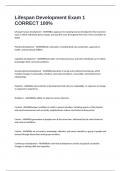Exam (elaborations)
Lifespan Development Exam 1 CORRECT 100%
- Course
- Institution
Lifespan human development - ANSWERan approach to studying human development that examines ways in which individuals grow, change, and stay the same throughout their lives, from conception to death Physical development - ANSWERbody maturation, including body size, proportion, appearance, health,...
[Show more]



